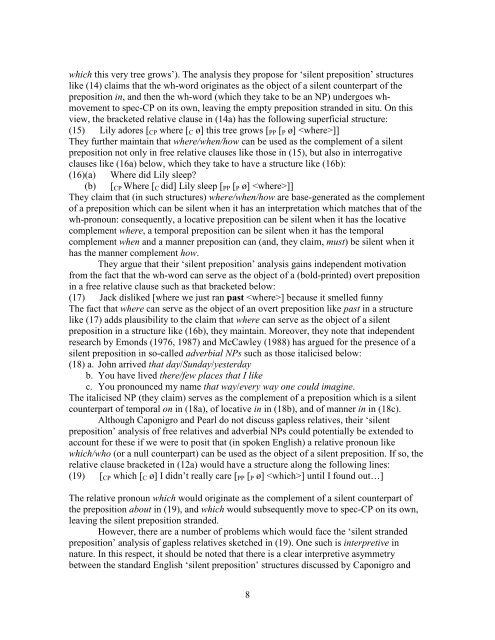1 GAPS, GHOSTS AND GAPLESS RELATIVES IN ... - ling.auf.net
1 GAPS, GHOSTS AND GAPLESS RELATIVES IN ... - ling.auf.net
1 GAPS, GHOSTS AND GAPLESS RELATIVES IN ... - ling.auf.net
You also want an ePaper? Increase the reach of your titles
YUMPU automatically turns print PDFs into web optimized ePapers that Google loves.
which this very tree grows’). The analysis they propose for ‘silent preposition’ structures<br />
like (14) claims that the wh-word originates as the object of a silent counterpart of the<br />
preposition in, and then the wh-word (which they take to be an NP) undergoes whmovement<br />
to spec-CP on its own, leaving the empty preposition stranded in situ. On this<br />
view, the bracketed relative clause in (14a) has the following superficial structure:<br />
(15) Lily adores [CP where [C ø] this tree grows [PP [P ø] ]]<br />
They further maintain that where/when/how can be used as the complement of a silent<br />
preposition not only in free relative clauses like those in (15), but also in interrogative<br />
clauses like (16a) below, which they take to have a structure like (16b):<br />
(16)(a) Where did Lily sleep?<br />
(b) [CP Where [C did] Lily sleep [PP [P ø] ]]<br />
They claim that (in such structures) where/when/how are base-generated as the complement<br />
of a preposition which can be silent when it has an interpretation which matches that of the<br />
wh-pronoun: consequently, a locative preposition can be silent when it has the locative<br />
complement where, a temporal preposition can be silent when it has the temporal<br />
complement when and a manner preposition can (and, they claim, must) be silent when it<br />
has the manner complement how.<br />
They argue that their ‘silent preposition’ analysis gains independent motivation<br />
from the fact that the wh-word can serve as the object of a (bold-printed) overt preposition<br />
in a free relative clause such as that bracketed below:<br />
(17) Jack disliked [where we just ran past ] because it smelled funny<br />
The fact that where can serve as the object of an overt preposition like past in a structure<br />
like (17) adds plausibility to the claim that where can serve as the object of a silent<br />
preposition in a structure like (16b), they maintain. Moreover, they note that independent<br />
research by Emonds (1976, 1987) and McCawley (1988) has argued for the presence of a<br />
silent preposition in so-called adverbial NPs such as those italicised below:<br />
(18) a. John arrived that day/Sunday/yesterday<br />
b. You have lived there/few places that I like<br />
c. You pronounced my name that way/every way one could imagine.<br />
The italicised NP (they claim) serves as the complement of a preposition which is a silent<br />
counterpart of temporal on in (18a), of locative in in (18b), and of manner in in (18c).<br />
Although Caponigro and Pearl do not discuss gapless relatives, their ‘silent<br />
preposition’ analysis of free relatives and adverbial NPs could potentially be extended to<br />
account for these if we were to posit that (in spoken English) a relative pronoun like<br />
which/who (or a null counterpart) can be used as the object of a silent preposition. If so, the<br />
relative clause bracketed in (12a) would have a structure along the following lines:<br />
(19) [CP which [C ø] I didn’t really care [PP [P ø] ] until I found out…]<br />
The relative pronoun which would originate as the complement of a silent counterpart of<br />
the preposition about in (19), and which would subsequently move to spec-CP on its own,<br />
leaving the silent preposition stranded.<br />
However, there are a number of problems which would face the ‘silent stranded<br />
preposition’ analysis of gapless relatives sketched in (19). One such is interpretive in<br />
nature. In this respect, it should be noted that there is a clear interpretive asymmetry<br />
between the standard English ‘silent preposition’ structures discussed by Caponigro and<br />
8
















